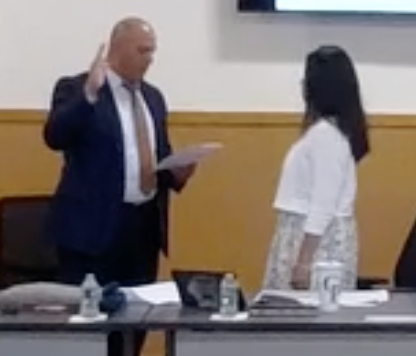Group warns against toxins in drinking water
A report by the Farmingdale-based Citizens Campaign for the Environment (CCE) reveals elevated levels of a possible carcinogen in water districts throughout Long Island.
Found in various personal-care products, the cancer-causing chemical, 1,4-dioxane, is listed as “likely to be carcinogenic to humans” by the Environmental Protection Agency (EPA). And according to CCE, Long Islander water supplies have the highest levels of 1,4-dioxane in the nation.
In response to the findings, the group has devised an interactive map at http://www.citizenscampaign.org/campaigns/dioxane.asp so that residents can investigate contamination levels in their local groundwater. According to the map, the Westbury Water District, with 10 wells serving the population of about 20,500 people in New Cassel, most of Westbury and a portion of Old Westbury, did detect 1,4 dioxane in levels about the EPA’s cancer risk guideline.
 Westbury Water District Commissioner Vincent Abbatiello said that the district became aware of the presence of 1,4 dioxane in 2014.
Westbury Water District Commissioner Vincent Abbatiello said that the district became aware of the presence of 1,4 dioxane in 2014.
“The district has taken the position that this is an emerging contaminant that deserves to be monitored but until there are guidelines established there is nothing that the district can do other than continued monitoring,” said Abbatiello. “Since the district has detected levels of 1,4-dioxanne well below the NYSDOH standard of 50 (ppm) and there are no federal or state guidelines as to an acceptable Mcl (maximum contaminant level), there is no way for the district to determine the best method for removal of this particular chemical. As with other contaminants, the acceptable level may be well above the levels being experienced by the district and as a result may not require any action at all.”
He went on to say that district residents were provided with a copy of the Annual Water Quality Report, which lists all chemicals and constiuents tested for were listed.
“Since there are no guidelines or Mcl thresholds there is nothing else to notify residents of at this time,” Abbatiello said.
In Carle Place, five wells service the population of 8,900 over the 1.5 square mile service area in Carle Place and part of Westbury. According to the CCE map, the district is not testing for 1,4 dioxane.
James Neri, an engineer and consultant for the Plainview Water District, said that consumers would have to ingest an impossibly large amount of water before it became detrimental to health.
“You would have to consume two liters per day for 70 years before you would have a one-in-a-million increased chance of cancer,” said Neri. “They are trying to compel the EPA to move faster, and that’s not necessarily a bad thing, but they are pandering to the side of fear.”

Neri said water districts are trying to vet new technologies aimed at stemming the tide of dioxane, but that the “water is absolutely safe to use.”
In a statement, the CCE said that to avoid further contamination, Long Islanders should avoid products containing dioxane.
“While dioxane itself is not listed on the label, it occurs as a byproduct of processing certain ingredients, and those ingredients are often listed,” said the CCE.
Two of the most common at-risk ingredients are “sodium laureth sulfate” and “potassium laureth phosphate.” Other commonly used ingredients associated with 1,4-dioxane contamination include PEG, polyethylene, polyethylene glycol, polyoxyethylene, myreth, oleth, laureth and ceteareth. Other than these, look for any ingredients with “-eth” or “-oxynol” in their names.
Dioxane gets into the water through products that contain it, including laundry detergent, soap, shampoo and body wash, according to CCE’s report. That report reveals that up to 46 percent of personal-care products contain the chemical, which is not added to consumer goods but rather is an unwanted byproduct of ethoxylation—a process used to reduce skin irritation caused by petroleum-based ingredients. Once in the groundwater and soil, the report stated, it is hard to remove and known as a “legacy” pollution—pollution left behind from past industrial activities—and is also a source of dioxane contamination.
“While avoiding products in our personal lives is a good first step, we need New York state to act now to prevent further exposure to dioxane through our drinking water,” CCE said. “Right now, there is no federal health-based drinking water standard for dioxane, even though the EPA considers ingestion from drinking water to be the most dangerous route of exposure for dioxane.”
Senators Kirsten Gillibrand and Chuck Schumer recently announced legislation that would require the EPA to develop a maximum contaminate level for 1,4-dioxane and other hazardous chemicals in public water systems. As 1,4-dioxane is currently unregulated in the Safe Water Drinking Act, this legislation would require the EPA to create safety guidelines and determine legally enforceable standards that apply to water systems.
“We’ve seen very clearly how much damage can happen to our local drinking water supplies when toxic chemicals like PFOA, PFOS, 1,4-dioxane, and perchlorate aren’t monitored by the EPA,” said Gillibrand, a member of the Senate Environment and Public Works Committee. “New Yorkers should be able to drink water without having to worry about whether it’s safe. Anything less than that standard is unacceptable.”
In January, Schumer and Gillibrand called on the EPA to prioritize and accelerate the risk evaluation for 1,4-dioxane.
“We need a maximum contaminant level set by the EPA for perfluorinated compounds like PFOA/PFOS, 1,4-dioxane and perchlorate,” said Schumer. “I will use every ounce of my clout to work with my colleagues in the Senate and make sure this common sense public health bill to ensure safe drinking water is passed.”
—With additional reporting by Betsy Abraham

































